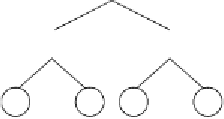Information Technology Reference
In-Depth Information
a.
012345678901201234567890120123456789012
*Qb+*/
bbbabab
-a+QbQ
bbababa
/ba-/*
bbaaaaa
b.
Sub-ET
1
Sub-ET
2
Sub-ET
3
/
Q
a
b
b
a
Q
b
Q
/
b
b
b
a
b
Figure 2.2.
Expression of GEP genes as sub-ETs.
a)
A three-genic chromosome
with the gene tails shown in bold. Position 0 marks the start of each gene.
b)
The
sub-ETs codified by each gene.
In summary, the chromosomes of gene expression programming contain
several ORFs, each ORF coding for a structurally and functionally unique
sub-ET. We will see that, depending on the problem at hand, these sub-ETs
may be selected individually according to their respective fitness (for exam-
ple, in problems with multiple outputs), or they may form a more complex,
multi-subunit ET and be selected according to the fitness of the whole, multi-
subunit ET. The patterns of expression and the details of selection will be
often discussed in this topic. However, keep in mind that each sub-ET is both
a separate entity and part of a more complex, hierarchical structure, and, as
in all complex systems, the whole is more than the sum of its parts.
2.2 Expression Trees and the Phenotype
In nature, the phenotype has multiple levels of complexity, being the most
complex the organism itself. But tRNAs, proteins, ribosomes, cells, and so
forth, are also products of expression and all of them are ultimately encoded
in the genome.
In contrast to nature, in gene expression programming, the expression of
the genetic information is very simple. Nonetheless, as we have seen in







